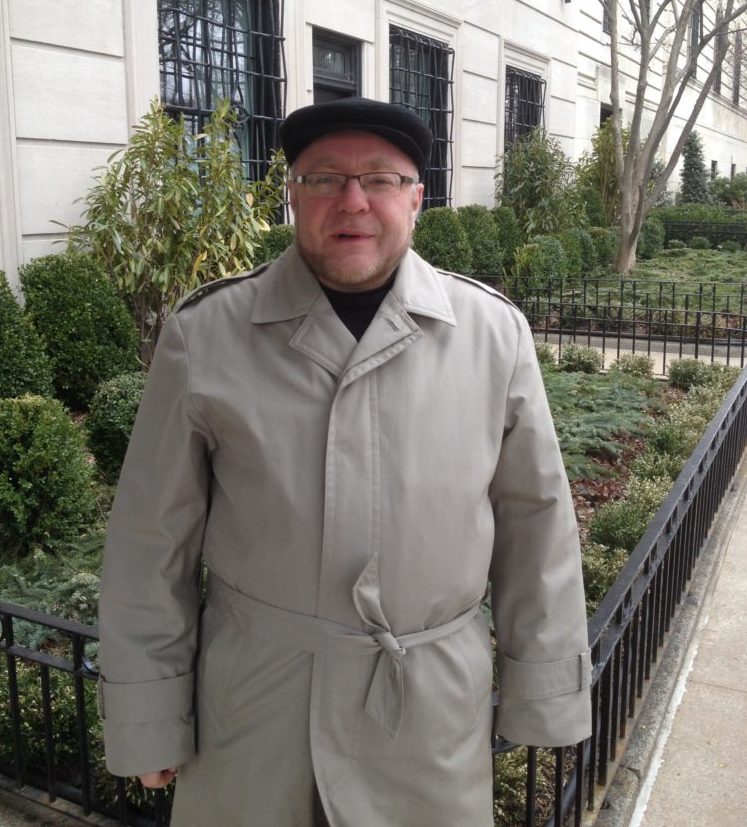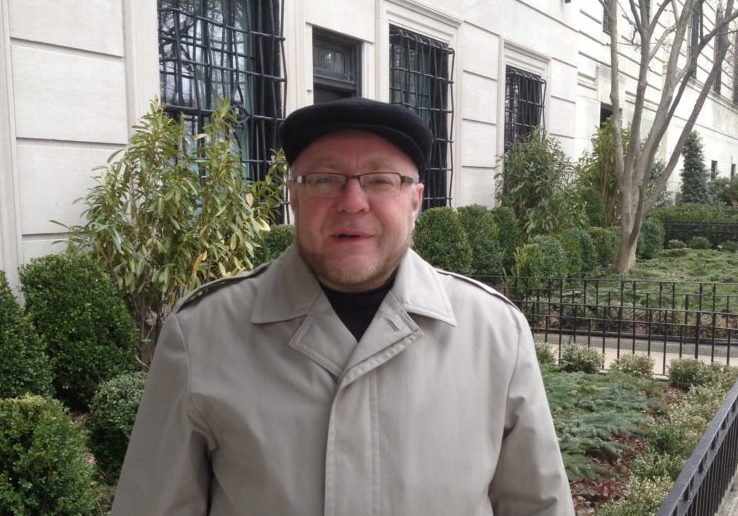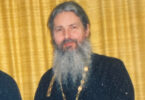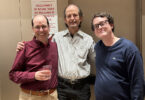Dmitri Pavlovich, please tell us about your education. How does it help with your research?
I have two degrees. In 1993 I graduated from the Moscow State Pedagogic University. In 1994 I entered our Holy Trinity Seminary, from which I graduated in 1998. As you can see, my initial training makes me a historian, while my second one makes me a theologian. I am currently a history instructor at a seminary, so I’m utilizing both of my decrees. Theological education and historical education complement each other. You understand Church history better when you know civilian history, since the Church doesn’t exist separately from society and the state. The Church is influenced by thousands of processes and events taking place in the world, while the Church in turn influences life around it. Knowledge of civil history allows a wider view of Church history and gives more opportunities of explaining the processes taking place in it. On the other hand civilian history reveals itself differently when analyzed from the viewpoint of a person of the Orthodox Church. Thus, the actions of people of the past, all of whom were believers, are so much more understandable. It’s quite important that at the institute I became proficient in research methodology, working with sources, and analyzing scientific data.
When did you start teaching at Holy Trinity Seminary, and what are your subjects?
I’m currently teaching Church History, starting in 2003. From 2004 till 2010 I taught Russian History and the History of the World and Civilization, which actually turned out to be an intensive study of the Byzantine Empire.
What value for the contemporary Orthodox person do you see in studying the history of the Byzantine Empire?
We could say that the Russian people obtained Orthodoxy from Byzantium in ready form. Up to the end of the eighteenth century, whenever any problems arose in the Russian Church we would simply send ambassadors to Constantinople and inquire what we should do about them. Our services were developed in Byzantium, our canon law was set down at the Ecumenical Councils that also took place in Byzantium, and the great theologians of the Orthodox Church from the fourth to the fifteenth centuries likewise lived in Byzantine territory. Byzantium also left for us a multitude of ascetics. Byzantium is Mount Athos, Meteora, Sinai, and Mistra. Byzantium isn’t only hoary antiquity, but a living legacy of Orthodoxy in existence to this very day. Studying the legacy of the Byzantine Empire allows us, the Orthodox who are living today, to grasp, comprehend, and explain our faith. Besides, we must not forget that many of the problems that the Church faces today have their roots in Byzantium, and knowledge of its history will help us get to the heart of these problems, and thus to solve them as well.
We congratulate you with the publication this year of two of your books. Please tell us about “Orthodox Resistance.”
This book has two authors, Mikhail Vitalievich Shkarkovskii and myself. Dr. Shkarkovskii is a well-known historian from Petersburg. He has been working on the Josephite and Non-commemorator Movements for a long time. We could say this is his specialty. I, in turn, have been interested in the history of the Catacomb Church in Russia. At some point we decided to combine our efforts and create a small encyclopedia containing biographies of non-commemorators, which would cover the period from 1927 to the end of the 1980’s chronologically. Mr. Shkarkovskii worked in the archives of the Russian secret services, while I worked in our seminary archives, where A.V. Psarev had collected a small repository on this topic. In this way we open up to research a great deal of documents that had previously been inaccessible to researchers and readers. At the last stage my task was to systematize the data and to bring the book to completion—in other words, to conclude the project. In the process only biographies of Church figures whose canonicity gives rise to no doubts made it into the collection. We would try to brush aside those whose canonicity or actual existence we found questionable. The data is organized in a hierarchical fashion. First come biographies of hierarchs, followed by clergy, monastics, and laity. This collection contains only biographical information — we tried to avoid our own commentary. There has been much bias in giving an appraisal of the actions of those who didn’t accept the course taken by Metropolitan Sergius (Stragorodskii). If the official circles in Russia mentioned them, they were usually referred to as schismatics, politicians, or extremists. The attitude outside Russia and among the dissidents in Russia was totally different. And now the time has come to figure everything out without looking back at semi-official proclamations or jurisdictional membership.
Could you mention certain biographical information that impressed you? Those are the biographies of non-commemorators who were almost our contemporaries, such as Nikita Lekhan, Feodor Rafanovich, and Amvrosy Parbus. Most of the non-commemorators perished during the Great Terror in the late thirties. Many were arrested during or after World War II. In any case, they had spent most of their lives back before the Revolution in a pious Orthodox atmosphere. Even in the thirties there were still many believers who had been born and were raised under the Tsar. The period of illegal or semi-legal existence of these Church servers wasn’t that lengthy. Those who were still alive between the sixties and the eighties had undergone the feat of underground service for a number of decades. They saw the new generation growing up, as everything that they loved and served for seemed to fade into the past forever. Just imagine hiding day after day, expecting arrest, for several decades. They were always on edge. We can add to this the absence of a canonical hierarch and the demise of one fellow clergyman after another. This would gradually leave you alone with a small group of devoted followers. A totally different way of life is developing around you, one that makes you a stranger who gradually turns into a relic of an era that is gone forever. It seems that this is the way things will always be, and that there is almost no hope of changing the situation. Some of the catacomb priests felt that they were the last ones. It is no wonder that one of them, Fr. Michael Rozhdestvenskii, entrusted his flock to the Mother of God before dying. In these conditions maintaining faith in God and continuing pastoral service amounted to a great act of heroism
Could you mention some historic data that impressed you?
Audio recordings of talks and interviews of the participants in the catacomb movement was what impressed me the most. These were living voices of the immediate participants in the events, who had themselves been persecuted. Their stories, which were often very simple, convey the whole atmosphere of that life, full of danger and tension, in all of its unrepeatable coloring. Living testimonies of eyewitnesses bear no comparison to any paper documents in their emotional tension and their significance for the understanding of the events.
Please tell us about your collection “Legislation of the Russian Orthodox Church Abroad, 1920-2007.” What is it all about?
This book is an attempt to collect laws, decrees, and instructions of the Russian Orthodox Church Abroad into one volume. This is the most complete collection of the laws and decrees of the Russian Orthodox Church Abroad to date. In their dispersal the clergy and flock of the Russian Church frequently found themselves in such situations that simply could not have arisen neither in tsarist Russia nor in the Soviet Union. The new living conditions required an adequate reaction in the form of Church legislation. In this way the legislative framework of the Russian Church Abroad arose, precisely reflecting the specifics of its existence. Various decrees and instructions were scattered among the pages of Church publications and weren’t compiled in a single volume, which made their use difficult. The legislation of the Russian Orthodox Church Abroad, systematized and gathered together, is now accessible. The collection is intended both for practical use and for scholarly research. Thus, it includes not only currently valid legislation, but that which, while being of exclusively historic interest, reflects the complex path of the Church Abroad. The need to compile a single volume of the legislation of the Russian Church Abroad became urgent long ago. In ROCOR itself the memory of decisions that had been made at some point was gradually disappearing. In Russia they were totally unknown, which paved the way for various rumors and falsifications. The data in the book deals with all aspects of Church life, from diocesan administration to parish traditions.
What was the reaction to this collection?
So far, the reaction is positive. The February 2013 issue of the Journal of the Moscow Patriarchate published a review by Professor Andrei Kostrukov of St. Tikhon University that was sufficiently favorable. In personal conversations clergymen and certain of my colleagues are likewise expressing their gratitude. But I’ll be thankful for constructive criticism as well.
Your article entitled “Church Conservatism in Contemporary Society” was published on our website. You recently completed an analytical article on the relationship of the Russian Church Abroad to the Vietnam War. Please tell us about your approach toward historic data.
Working with the data is the basic task of the researcher. It consists of three stages. First, there is the collection of the data, then its systematization, and, finally, its interpretation and analysis. I would say that to a certain extent the data guides me, rather than the other way around. It determines the nature of the research and the conclusions the author makes. However, we cannot go here to the extreme of accepting simply everything that appears in a particular document, or what a historian has written, or what has been related by eyewitnesses. One should always try to analyze the data critically, asking about its provenance, who the author is, whose interests he represents, what the purpose was of a particular document, who published it and why, and so on. Many factors need to be taken into account in source analysis. This applies not only to documents but also to audio and video material. And in the process, objectivity must be maintained as much as possible. I feel that one cannot tailor the data to personal convictions or to the views of the group to which the author belongs. If a certain figure made mistakes, that should be stated regardless of the position he held in the ecclesiastical or secular hierarchy. For example, we can say that a particular bishop is right because he is right, or else that he is right because he’s a hierarch and our bishop. These are two different approaches — either trying to discover the truth or defending the position of the leadership while foaming at the mouth. And one shouldn’t sink to spiteful gloating or politicizing, but try instead to explain calmly the reason for a particular mistake or wrong actions. History has been such as it was rather than what we would have liked it to be. Such an approach allows us first of all to look at ourselves objectively. This is very difficult, and I often cannot manage to maintain such a course, perhaps because any researcher is still a person with his own convictions, views, and life experience.
How does your experience of living in and outside Russia influence your research?
 Interacting with people takes first place here. It was in the emigration, as in some sort of preserve, that one could encounter members of the Russian Military Union, the Russian Army of Liberation, dispossessed kulaks, those who had served in Manchukuo Army, genuine Russian aristocrats, or those who had left Russia for the West with the Wehrmacht during World War II. Their stories, or those of their descendants, their destinies, and personal interaction with them allowed me to overcome many of the stereotypes I had acquired as a result of Soviet upbringing, and, in part, its education. On the other hand a different mythology was developed outside Russia. Knowledge of the actual situation in Russia allows one not to be captivated by the fear mongering and stereotypes occurring in the emigration and at the same time not to regard Russia through rose-coloured glasses. The same goes for the experience of living outside of Russia, which lets one look at it from Russia in a more or less realistic manner, without excessive idealizing and demonizing. It’s one thing to read newspapers and watch television, and it’s a totally different matter to see life transpiring around you. Life experience in Russia and outside Russia enhances to a possible extent a more open-minded and objective view of both the past and the present
Interacting with people takes first place here. It was in the emigration, as in some sort of preserve, that one could encounter members of the Russian Military Union, the Russian Army of Liberation, dispossessed kulaks, those who had served in Manchukuo Army, genuine Russian aristocrats, or those who had left Russia for the West with the Wehrmacht during World War II. Their stories, or those of their descendants, their destinies, and personal interaction with them allowed me to overcome many of the stereotypes I had acquired as a result of Soviet upbringing, and, in part, its education. On the other hand a different mythology was developed outside Russia. Knowledge of the actual situation in Russia allows one not to be captivated by the fear mongering and stereotypes occurring in the emigration and at the same time not to regard Russia through rose-coloured glasses. The same goes for the experience of living outside of Russia, which lets one look at it from Russia in a more or less realistic manner, without excessive idealizing and demonizing. It’s one thing to read newspapers and watch television, and it’s a totally different matter to see life transpiring around you. Life experience in Russia and outside Russia enhances to a possible extent a more open-minded and objective view of both the past and the present











